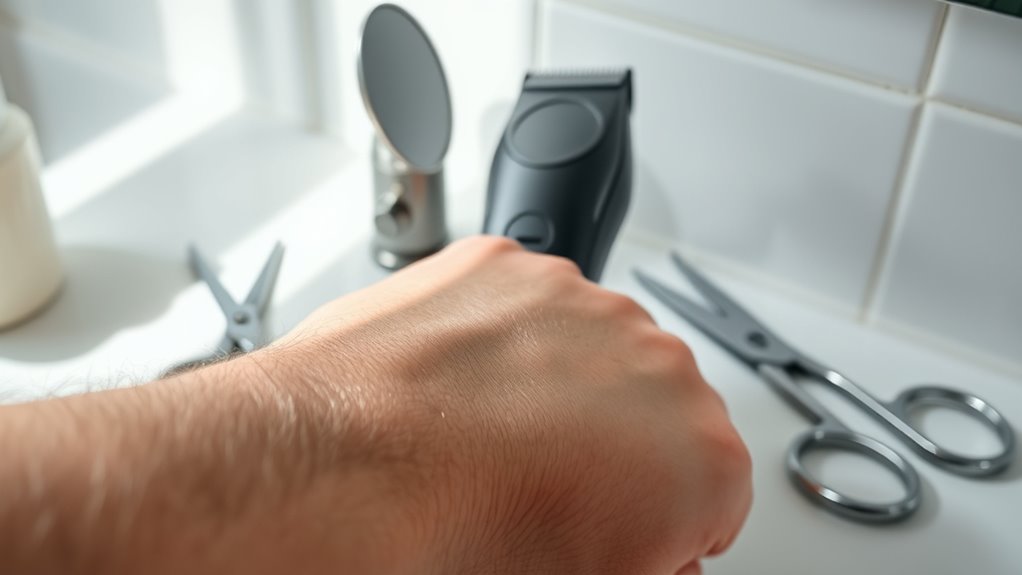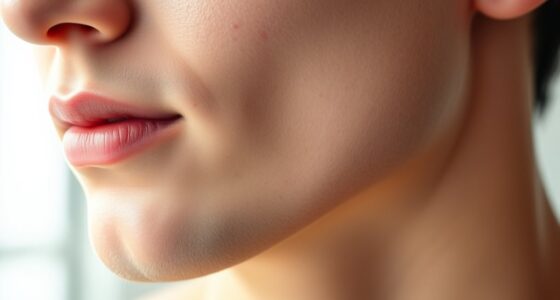To trim body hair safely, use sharp, clean tools like quality trimmers with adjustable guards or small scissors for precision. Always prepare a well-lit, sanitized workspace, and soften hair with shaving gel or trimming cream beforehand. Move the trimmer in the direction of hair growth and start with longer guard settings before going shorter for detail work. Proper technique and effort guarantee a smooth, irritation-free finish—keep going, and you’ll discover even more tips for a flawless trim.
Key Takeaways
- Use sharp, clean trimmers with adjustable guards for precise, safe trimming of body hair.
- Prepare a clean, well-lit workspace and familiarize yourself with your tools before starting.
- Trim in the direction of hair growth, starting with longer guard settings and gradually shortening for detail.
- Maintain hygiene by cleaning tools regularly and using shaving gel or trimming cream to reduce irritation.
- Work slowly and patiently, ensuring proper technique to achieve a polished look safely and effectively.

Trimming body hair is a simple way to maintain a neat appearance and feel more comfortable. Whether you’re preparing for a special occasion or just want to keep things tidy, choosing the right tools and techniques makes all the difference. One of the most important aspects of trimming is razor safety. You want to avoid cuts, nicks, or irritation, which means you should always use sharp, clean blades and handle them carefully. Dull razors tend to tug at the hair instead of cutting it smoothly, increasing the risk of injury and discomfort. Using a razor guard or a safety razor can help prevent accidental cuts, especially if you’re new to trimming or working in sensitive areas. Always make sure to use a mirror and work slowly, paying attention to your movements. Applying a shaving gel or trimming cream beforehand can soften the hair and provide a smoother glide, reducing the chances of irritation or razor burn.
In addition to razor safety, incorporating the right trimming accessories can elevate your grooming routine. A quality trimmer with adjustable guard lengths offers precision and versatility, allowing you to customize your trim according to your preferred length. Cordless trimmers are convenient and easy to maneuver, especially when trimming hard-to-reach areas. For finer detailing, small scissors or precision trimmers come in handy, giving you control over shaping and defining your body hair. Many grooming sets also include nose and ear trimmers, which are designed with safety features to prevent cuts or punctures. Using these accessories properly ensures a clean, even trim without risking injury. When choosing your tools, opt for those made from durable, stainless steel or high-quality plastic, as they tend to last longer and are easier to sanitize. Additionally, understanding proper tool maintenance can extend the lifespan of your grooming equipment and ensure safety during use.
Before starting, gather all your accessories and set up a well-lit, clean workspace. Take your time to familiarize yourself with the equipment, especially if you’re using a new trimmer or razor. Start with longer guard settings if you’re new to trimming, then gradually work your way to shorter lengths for a closer cut. Always move in the direction of hair growth to achieve a more natural look and minimize irritation. After trimming, rinse your tools thoroughly and store them properly to prevent bacteria buildup. Remember, consistency is key to achieving a polished appearance, but never rush the process. Patience and attention to detail will help you avoid mishaps and leave you feeling confident with your groomed look. Proper technique combined with the right accessories makes trimming body hair straightforward, safe, and effective.
Frequently Asked Questions
How Often Should I Trim My Body Hair?
You should trim your body hair every 1 to 3 weeks, depending on your hair growth cycles and personal preference. Regular trimming helps maintain your desired look and prevents hair from becoming uneven. If your hair grows quickly, you might need to trim more often; for slower growth, less frequent trims work. Pay attention to how your hair responds and adjust your trimming schedule accordingly to keep it neat and comfortable.
Can I Use the Same Tools for All Body Areas?
Using the same tools for all body areas is like using one brush for every painting—it’s not ideal. You shouldn’t, as different areas need specific tools for effective trimming and hygiene. Always clean and maintain your tools after each use to prevent bacteria. Adjust your trimming frequency based on the area, ensuring each tool stays sharp and effective. Proper tool maintenance keeps your grooming routine safe and efficient.
Are There Safety Tips for Trimming Sensitive Areas?
Yes, there are safety tips for trimming sensitive areas. You should use a clean, sharp trimmer designed for sensitive skin, and avoid sharing tools to maintain hygiene practices. Always trim slowly and gently to prevent irritation, and consider using trimming cream or gel for smoother results. After trimming, rinse the area with cool water, pat dry, and apply a soothing moisturizer to reduce skin sensitivity and prevent discomfort.
What Are the Best Tools for Thick or Coarse Hair?
Did you know that over 60% of people with thick or coarse hair struggle to find effective tools? For the best results, use electric shavers designed for dense hair, offering powerful blades and guard options. Trimming scissors with sharp, high-quality blades also work well for precision. Combining these tools helps you tame stubborn hair efficiently, ensuring a smooth, comfortable trim every time.
How Do I Prevent Skin Irritation After Trimming?
To prevent skin irritation after trimming, you should avoid skin sensitivity issues by using a sharp, clean trimmer and trimming in the direction of hair growth. Afterward, apply a soothing, fragrance-free moisturizer to calm your skin. Incorporate moisturizing routines regularly to maintain skin health, and consider using aloe vera gel or cold compresses if irritation occurs. These steps help reduce redness, irritation, and keep your skin smooth and healthy.
Conclusion
Now that you know the tools and techniques, you’re ready to master body hair trimming with confidence. Remember, it’s not just about maintaining your look but feeling comfortable in your skin. Think of it as your personal renaissance—embracing self-care as an art. So, grab your tools and approach each trim like a true pioneer of your own journey, because in the end, it’s all about your comfort and confidence, no matter what the future holds.









